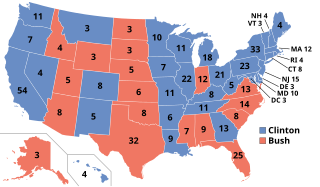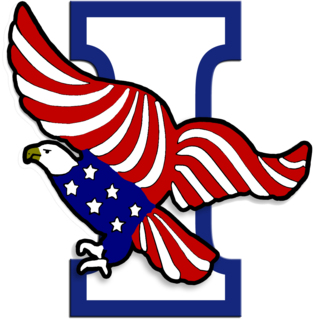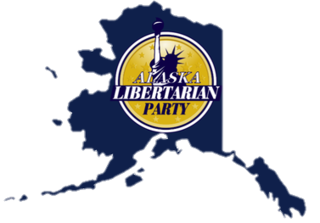
The 1996 United States presidential election was the 53rd quadrennial presidential election, held on Tuesday, November 5, 1996. Incumbent Democratic President Bill Clinton defeated former Senate Majority Leader Bob Dole, the Republican nominee, and Ross Perot, the Reform Party nominee and 1992 Independent presidential candidate.

The 1992 United States presidential election was the 52nd quadrennial presidential election, held on Tuesday, November 3, 1992. Democratic Governor Bill Clinton of Arkansas defeated incumbent Republican President George H. W. Bush and independent businessman Ross Perot of Texas. The election marked the end of a period of Republican dominance in American presidential politics that began in 1968, and also marked the end of 12 years of Republican rule of the White House, as well as the end of the Greatest Generation's 32-year American rule and the beginning of the baby boomers' 28-year dominance until 2020. It was the last time the incumbent president failed to win a second term until 2020, when Donald Trump lost the election to Joe Biden; it was the first such occurrence since 1980.

The Peace and Freedom Party (PFP) is a left-wing political party with affiliates and former members in more than a dozen American states, including California, Colorado, Florida, Hawaii, Indiana and Utah, but none now have ballot status besides California. Its first candidates appeared on the 1966 New York ballot. The Peace and Freedom Party of California was organized in early 1967, gathering over 103,000 registrants which qualified its ballot status in January 1968 under the California Secretary of State Report of Registration.
American electoral politics have been dominated by successive pairs of major political parties since shortly after the founding of the republic of the United States. Since the 1850s, the two largest political parties have been the Democratic Party and the Republican Party—which together have won every United States presidential election since 1852 and controlled the United States Congress since at least 1856. Despite keeping the same names, the two parties have evolved in terms of ideologies, positions, and support bases over their long lifespans, in response to social, cultural, and economic developments—the Democratic Party being the left-of-center party since the time of the New Deal, and the Republican Party now being the right-of-center party.

The Reform Party of the United States of America (RPUSA), generally known as the Reform Party USA or the Reform Party, is a centrist political party in the United States, founded in 1995 by Ross Perot.
Third party is a term used in the United States for political parties other than the two dominant parties, currently the Republican and Democratic parties. Sometimes the phrase "minor party" is used instead of "third party".
Elections in the United States refers to the rules and procedures regulating the conditions under which a candidate, political party, or ballot measure is entitled to appear on voters' ballots. As the nation's election process is decentralized by Article I, Section 4, of the United States Constitution, ballot access laws are established and enforced by the states. As a result, ballot access processes may vary from one state to another. State access requirements for candidates generally pertain to personal qualities of a candidate, such as: minimum age, residency, citizenship, and being a qualified voter. Additionally, many states require prospective candidates to collect a specified number of qualified voters' signatures on petitions of support and mandate the payment of filing fees before granting access; ballot measures are similarly regulated. Each state also regulates how political parties qualify for automatic ballot access, and how those minor parties that do not can. Fundamental to democracy, topics related to ballot access are the subject of considerable debate in the United States.
Vote splitting is an electoral effect in which the distribution of votes among multiple similar candidates reduces the chance of winning for any of the similar candidates, and increases the chance of winning for a dissimilar candidate. This is commonly known as the spoiler effect, which can discourage minor party candidacies.

The Independence Party is a political party in the U.S. state of New York. The party was founded in 1991 by Gordon Black, Tom Golisano, and Laureen Oliver and acquired ballot status in 1994. They lost their ballot status in 2020 under a change in the New York state election law that required at least 130,000 votes on the party line every two years. Although often associated with Ross Perot, as the party came to prominence in the wake of Perot's 1992 presidential campaign, it was created prior to Perot's run. In 2020, it affiliated with the Alliance Party, but disaffiliated in 2021. It used to have one elected member of the New York State Assembly, Fred Thiele, until Thiele switched his party affiliation to the Democratic Party in 2022. On December 9, 2022, New York governor Kathy Hochul signed S1851A, banning the use of the words "Independent" and "Independence" from use in political party names in New York state.
The Conservative Party in the United States refers to various state parties that have no connection with one another and that support conservatism in the United States.

Steven Mark Lonegan is an American businessman and politician who served as mayor of Bogota, New Jersey, from 1996 to 2007. He was also the Republican Party's nominee in the 2013 Special Senate election in New Jersey, which he lost to Cory Booker.
New Jersey is one of the fifty U.S. states. The state is considered a stronghold of the Democratic Party and has supported the Democratic candidate in every presidential election since 1992. Democrats have also controlled both chambers of the state legislature since 2004. New Jersey currently has two Democratic United States senators. New Jersey's Class I Senate seat has been Democratic since 1959. New Jersey's Class II Senate seat has been Democratic since 1979. In addition, New Jersey's House congressional delegation has had a Democratic majority since 1965, except for a period between 1995-1999 and 2013-2017. As of July 1, 2020, there were more registered Democrats than unaffiliated voters for the first time in history, as there are more Democrats than Republicans as well.

The 2001 New Jersey gubernatorial election was a race for the Governor of New Jersey. It was held on November 6, 2001. Primaries took place on June 25. Democratic nominee Jim McGreevey won the general election with 56% of the vote — the first majority-elected governor since James Florio in 1989. His Republican opponent in that race was Bret Schundler.

The 2009 New Jersey gubernatorial election took place on November 3, 2009. Incumbent Democratic Governor Jon Corzine ran for a second term against Republican Chris Christie, Independent Christopher Daggett, and nine others, in addition to several write-in candidates. Christie won the election, with about 48.5 percent of the vote, to 44.9 percent for Corzine and 5.8 percent for Daggett. He assumed office on January 19, 2010. This was the first election to fill the newly created office of lieutenant governor, with the candidates for governor choosing their running mates. Kim Guadagno, Christie's running mate, became New Jersey's first lieutenant governor following her inauguration.

Persons 18 years or older on the general election date were eligible to register and vote in the general election. The following offices were up for election in the United States State of New Jersey in the general election on November 3, 2009:

The 1994 United States Senate Election in New Jersey was held November 8, 1994. Incumbent Democratic U.S. Senator Frank Lautenberg won re-election to a third term.

The Libertarian Party of Alaska is the affiliate of the Libertarian Party (LP) in Alaska, headquartered in Anchorage.

The 2014 United States Senate election in New Jersey was held on November 4, 2014, to elect a member of the United States Senate to represent the State of New Jersey. Incumbent Democratic Senator Cory Booker, first elected in a special election the previous year, defeated Republican nominee Jeff Bell to win a first full term in office. This is the last time that Somerset County voted Republican in a statewide election.

United States gubernatorial elections were held on November 7, 2017, in two states: Virginia and New Jersey. These elections formed part of the 2017 United States elections. The last regular gubernatorial elections for these two states were in 2013. Both incumbents were term-limited, so both seats were open. Democrats held the governorship in Virginia and picked up the governorship of New Jersey.

The 1993 New Jersey gubernatorial election was held on November 2, 1993. Incumbent Democratic Governor James Florio was narrowly defeated by Republican former Somerset County freeholder and 1990 U.S. Senate nominee Christine Todd Whitman. Florio's defeat followed backlash from voters against his administration's tax increases. Whitman became the first female governor in the history of New Jersey.















